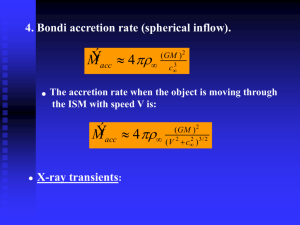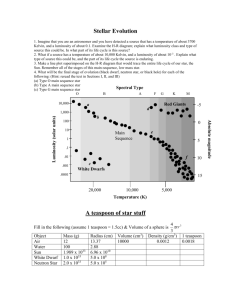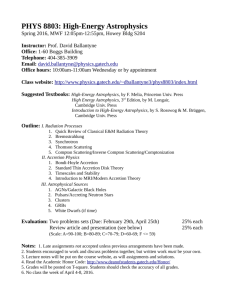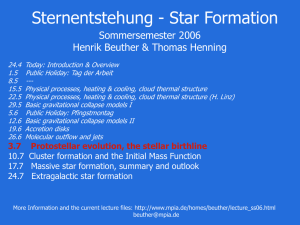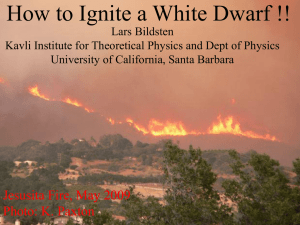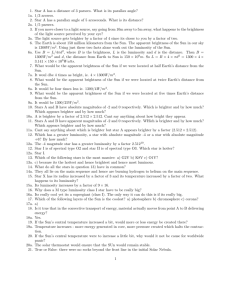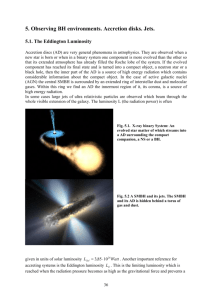protostars and pre-main
advertisement
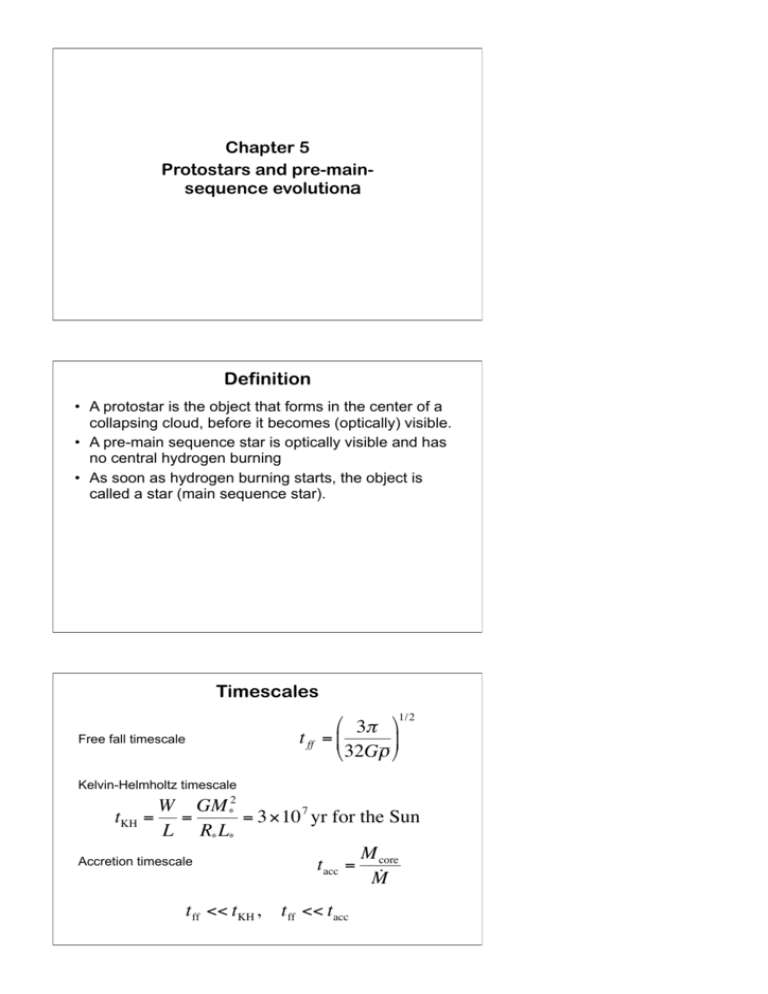
Chapter 5 Protostars and pre-mainsequence evolutiona Definition • A protostar is the object that forms in the center of a collapsing cloud, before it becomes (optically) visible. • A pre-main sequence star is optically visible and has no central hydrogen burning • As soon as hydrogen burning starts, the object is called a star (main sequence star). Timescales 3π 1/2 t ff = 32Gρ Free fall timescale Kelvin-Helmholtz timescale W GM *2 tKH = = = 3×10 7 yr for the Sun L R* L€* M Accretion timescale tacc = core M˙ € t ff << tKH , € € t ff << tacc 2 cases for timescales: tKH < tacc • Star evolved toward main sequence, contraction is slow, luminosity generated by contraction € tKH > tacc • Stellar interior does not adjust thermally as new matter get piled onto the top. Luminosity is generated at the surface by accretion shocka € First core • Ambipolar diffusion is faster in central dense region, so this is the the protostars forms as slow contraction. • Central lump becomes opaque to its own radiation: Isothermal approximation breaks down, the temperature rises steadily. • New matter settle on the core which is growing until it is 5AU and 5£10-2M¯ central temperature • Dissociation of H2 acts as a thermostat Virial theorem: R −1 µ GM M T≈ = 850K −2 3R R 5 ×10 M o 5AU Accretion Luminosity € • Gas falling onto the protostar heats the surface and radiates directly. This additional luminosity is called accretion luminosity Lacc Lacc M * R* −1 GM * M˙ M˙ = = 61Lo −5 R* 10 M o / yr 1M o 5Ro • Throughout the main accretion phase, Lacc accounts for most of Lrad. € • Other definition for protostar: Mass gaining star whose luminosity is dominated by accretion luminosity. Dust envelope and opacity gap • Dust is destroyed at 1500 K. • A gap forms between the protostar surface and the location of the 1500K boundary. • Dust photosphere is visible in IR observations. Stellar structure equations I Write hydrostatic end energy equations as function of Mr ∂r 1 = ∂M r 4 πr 2 ρ mass conservation ∂P GM ρ ∂P GM r = − 2r ⇒ =− ∂r r ∂M r 4 πr 4 € ρ P = kT equation of state µ m p Note: more complicated than in cloud hydrostatic equil. because of dissociation, ionization € € Stellar structure equations II radiative energy transport T3 ∂T 3κLint =− ∂M r 256π 2σ r 4 ∂Lint ∂s =ε −T ∂M r ∂t Energy production € specific entropy s. For simple monoatomic gas given by € k T 3/2 s = ln + s µ ρ 0 Stellar structure equations III Boundary conditions from ram pressure infall r(0) = 0 Lint (0) = 0 1/2 M˙ 2GM * P(M * ) = 4 π R*5 L* = Lacc + Lint (M * ) Final ingredient: Mass accretion rate, from collapse model. Equations are solved € using guessed central values for P, T, iterate until match with outer boundary conditions. Mass radius relation • Independent of initial condition after doubling of mass The onset of convection • Start produced by accretion are stable against convection, because the strengthening of the accretion shock lease to an increasing entropy profile. • Radiation can carry a limited amount of luminosity Lcrit 64 πGM rσT 3 ∂T = ∂P s 3κ • Once nuclear burning sets in, convection starts and leads to a constant specific entropy object. € Hayashi’s theory (1961) • Minimum surface temperature 4000-5000K – due to extremely strong dependence of the H- opacity on temperature • fully convective star – Star is fully convective, polytrope with index 3/2 γ p = Kρ = Kρ T ∝ p/ρ n+1 n = Kρ 5 / 3 p = KT n+1 = KT 5 /2 € Forbidden regime for young stars • Star is fully convective, polytrope with index 3/2 Deuterium burning LD = M˙ δ 10 6 K : 2 D + 1H → 3He + γ 10 7 K : H burning via pp chain or CNO cycle € • Deuterium luminosity is proportional to accretion rate and acts as a thermostat while star is fully convective. • But: Lrad M * 11/2 R* −1/2 = Lo M o Ro Deuterium burning log Teff Effect of the Deuterium thermostat on the zero D Observation of birthline in Taurus/Aurigae • Open circles are classical T Tauri stars (with disks and accretion • Filled circles are “weak-line” T Tauri stars, accretion has stopped, these are older.
